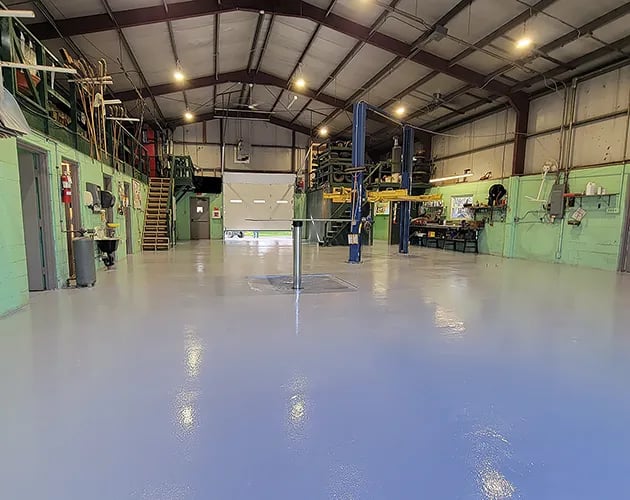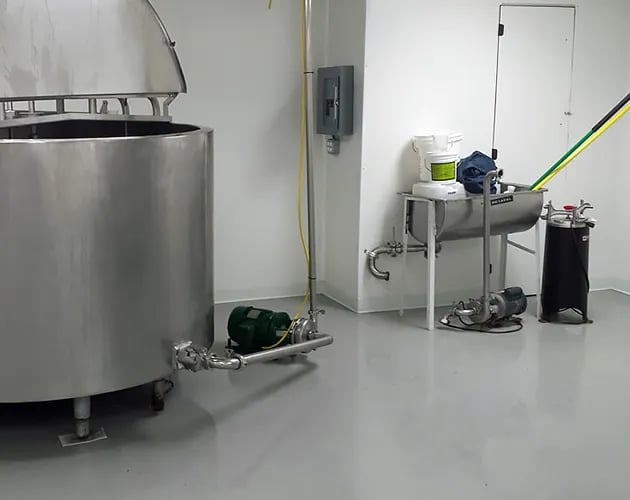Novolac Epoxy Floor Coatings
Specialty protection and secondary containment!
Broad Spectrum Chemical and Elevated Temperature Resistance from Novolac Epoxy
Novolac epoxies are specialty resins and hardeners that exceed the chemical, heat, and abrasion resistance of general epoxies. These coatings are the ideal solution for environments that deal with chemical spills on a daily basis or places that require secondary containment for stored chemicals. They are:
- Used to provide secondary containment in chemical storage environments.
- Ideal for battery storage, refilling, and recharging stations.
- Great for splash spill, short term, and long term immersion services.
- Designed with high abrasion resistance and may be combined with aggregates for higher build.
- A common choice for food processing environments.

Typical areas of use for novolac epoxy coatings are:
- Hazardous material vaults and chemical storage rooms
- Food processing
- Battery recharging and storage areas
- Chemical processing plants
- Pulp and paper mills
- Manufacturing involving solvents and caustic materials
Frequently Asked Questions about Novolac Epoxy Floor Coatings
The Environmental Protection Agency (EPA) has minimum requirements established in conjunction with the Resource Conservation and Recovery Act. The requirements pertain to the containment of hazardous waste and chemicals.
When hazardous waste and chemicals are stored in primary holding tanks or containers, the persons storing the materials must take precautions to contain the materials with a secondary containment zone in case the primary tanks or containers fail.
This secondary containment area must be able to prevent migration of any chemicals or liquids from within the secondary containment area into the surface water, ground water, or soil. It must be able to control the liquids or chemicals for a minimum period of 72 hours, which is the estimated amount of time necessary for removal and cleanup of the spill or leak.
Secondary containment is protection from a leak or spill of the primary container. Immersion service is where continual contact with a chemical or liquid is the norm - whether repeated splash spills or long term immersion. They each have different requirements, although some Novolac systems may function fine for both uses.
Novolacs are often used in troughs, spills areas, and mix stations due to the need for short term or long term immersion service against acids, solvents, and other chemicals.
- Cheese Processing
- Breweries
- Wineries
- Dairies
- Beverage Bottling
- Distilleries
Chemicals that Novolac Epoxy Protects Against
- Acetaldehyde
- Acetic acid
- Acetic acid glacial
- Acetic Anhydride
- Acetone
- Acetyl Chloride
- Acetonitrile
- Acrylic acid
- Acrylonitrile
- Adipic Acid
- Allyl Alcohol
- Aluminum Bromide
- Aluminum Chloride
- Aluminum Fluoride
- Aluminum Hydroxide
- Aluminum Nitrate
- Aluminum Sulfate
- Ammonia
- Ammonium Chloride
- Ammonium Flouride
- Ammonium hydroxide
- Ammonium nitrate
- Ammonium oxalate
- Ammonium persulfate
- Ammonium phosphate
- Ammonium sulfate
- Ammonium sulfide
- Ammonium sulfite
- Amyl acetate
- Amyl alchohol
- Aniline
- Aniline hydrochloride
- Antimony chloride
- Aqua regia
- Arsenous Acid
- Barium acetate
- Barium bromide
- Barium chloride
- Barium hydroxide
- Barium sulfate
- Barium sulfide
- Benzyl chloride
- Benzoic acid
- Benzaldehyde
- Benzene
- Benzyl alcholol
- Black liquor
- Blood sugar
- Borax
- Boric acid
- Brine
- Bromine liquid
- Butanol
- Butyl acetate
- Butyl acrylate
- Butyl amine
- Butyl carbitol
- Butyl cellosolve
- Butyl ether
- Butyric acid
- Calcium bisulfite
- Calcium bromide
- Calcium carbonate
- Calcium chlorate
- Calcium chloride
- Calcium hydroxide
- Calcium hypochlorite
- Calcium nitrate
- Calcium sulfate
- Calcium sulfite
- Calcium disulfide
- Carbon tetrachloride
- Castor oil
- Cellosolve
- Cellosolve acetate
- Chloroacetic acid
- Chlorobenzene
- Chloroform
- Chlorophenol
- Chlorosulfonic acid
- Chlorotoluene
- Chromic acid
- Chromic chloride
- Citric acid
- Copper acetate
- Copper chloride
- Copper cyanide
- Copper nitrate
- Copper sulfate
- Corn oil
- Corn starch slurry
- Corn sugar
- Cottonseed oil
- Creosote
- Creslic acid
- Cumene
- Cutting oil
- Cyclohexane
- Cyclohexanone
- Cymene
- Detergents organic
- Detergents sulfonated
- Dextrose
- Dibutyl phthalate
- Dichloracetic acid
- Dichlorobenzene
- Dichloroethane
- Diesel fuel
- Diethanolamine
- Diethyl benzene
- Diethyl ketone
- Diethylene glycol
- Diethyl ether
- Dimenthyl analine
- Dimethyl formamide
- Dimethyl sulfoxide
- Dinitro benzene
- Dinitro toluene
- Epichlorohydrin
- Ethanol
- Ethanolamine
- Ethyl acetate
- Ethyl acrylate
- Etheylamine
- Ethyl benzene
- Ethyl bromide
- Ethyl chloride
- Ethyl dichloride
- Ethylene glycol
- Ethyl sulfate
- Fatty acids
- Ferric chloride
- Ferric sulfate
- Ferrous nitrate
- Ferrous chloride
- Ferrous sulfate
- Fluosilicic acid
- Formaldehyde
- Formic acid
- Fuel oil
- Furfural alcohol
- Gasoline aviation
- Gasoline diesel
- Gasoline jet fuel
- Gasoline unleaded
- Glucose
- Glycerine
- Glycolic acid
- Green liquor
- Heptane
- Hexane
- Hydraulic fluid
- Hydrazine
- Hydriodic acid
- Hydrobromic acid
- Hydrochloric acid
- Hydroflouric acid
- Hydrogen peroxide
- Hydrogen sulfide
- Hypochlorous acid
- Iodine crystals
- Isophorone
- Isopropyl acetate
- Isopropyl alcohol
- Jet fuel (JP-4)
- Kerosene
- Lactic acid
- Lauric acid
- Lead acetate
- Levulinic acid
- Linseed oil
- Lithium bromide
- Lithium chloride
- Lithium hydroxide
- Magnesium bisulfite
- Magnesium carbonate
- Magnesium chloride
- Magnesium hydroxide
- Magnesium nitrate
- Magnesium sulfate
- Maleic acid
- Manganese chloride
- Manganese sulfate
- Mercuric chloride
- Mercurous chloride
- Methanol
- Methyl acetate
- Methylamyl alcohol
- Methyl benzoate
- Methyl chloride
- Methylene chloride
- Methyl ethyl ketone
- Methyl isobutyl ketone
- Milk
- Molassas
- Mineral oils
- Mineral spirits
- Motor oil
- M-pyrol
- Naphtha aliphatic
- Naphtha aromatic
- Nickel chloride
- Nickel nitrate
- Nickel sulfate
- Nitric acid
- Nitrobenzene
- Oil sour crude
- Oil sweet crude
- Oleic acid
- Oleum
- Oxalic acid
- Perchloric acid
- Perchloroethyle NE
- Phenol
- Phosphoric acid
- Picric acid
- Potassium acetate
- Potassium bromide
- Potassium carbonate
- Potassium chloride
- Potassium hydroxide
- Potassium iodide
- Potassium nitrate
- Potassium permanganate
- Potassium persulfate
- Potassium sulfate
- Propionic acid
- Propylene glycol
- Pyridine
- Salicylic acid
- Salt brine
- Silver nitrate
- Skydrol
- Sodium acetate
- Sodium benzoate
- Sodium bicarbonate
- Sodium bisulfate
- Sodium carbonate
- Sodium chlorate
- Sodium chloride
- Sodium chlorite
- Sodium chromate
- Sodium dichromate
- Sodium ferrocyanide
- Sodium hydroxide
- Sodium hypochlorite
- Sodium oxalate
- Sodium peroxide
- Sodium phosphate
- Sodium silicate
- Sodium sulfate
- Sodium sulfide
- Sodium sulfite
- Sodium tartrate
- Sodium thiosulfate
- Stearic acid
- Styrene
- Sulfamic acid
- Sulfuric acid
- Tall oil
- Tartaric acid
- Tetrochloroethane
- Tetrahydrofuran
- Thionyl chloride
- Toluene
- Toluene sulfonic acid
- Toluidene
- Trichloroacetic acid
- Trichloroethane
- Trichloroethyle NE
- Tricesyl phosphate
- Trisodium phosphate
- Turpentine
- Urea solutions
- White liquor
- Xylene
- Zinc chlorate
- Zinc sulfate






